Last Updated on August 7, 2025
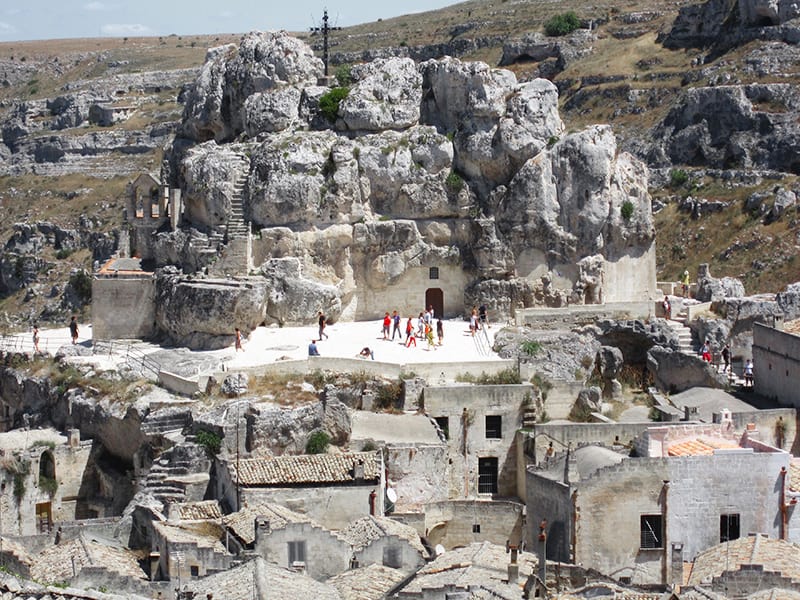
The Sassi of Matera was one of the stranger scenes I’d seen in my travels.
Estimated reading time: 5 minutes
By Jim Ferri
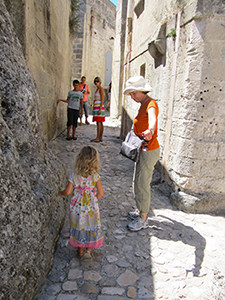
Standing on the rim of the ravine, I looked out across the sea of Matera’s buildings before me. They were stone houses, stores, churches, and everything imaginable, all scooped out of the rock for centuries.
It was both haunting and beautiful. And although it’s not one of the top places to visit in Italy, it’s undoubtedly one of the more bizarre.
I was in Matera, looking out at the Sassi, an old cave city (the word “sassi” means “caves”). It’s in the Basilicata region of southern Italy, about a three-hour drive south of Naples. People have been living in the Sassi since Paleolithic times.
Matera itself is an interesting southern Italian city. It is divided into an active upper district typical of many Italian towns and the lower silent Sassi.
Right in the center of Matera, Sassi was once a malaria-ridden slum. It was also one of the most poverty-ridden areas of southern Italy. In the 1950s and 1960s, it became such a national embarrassment that the Italian government moved all its residents to new apartments on the outskirts of Matera.
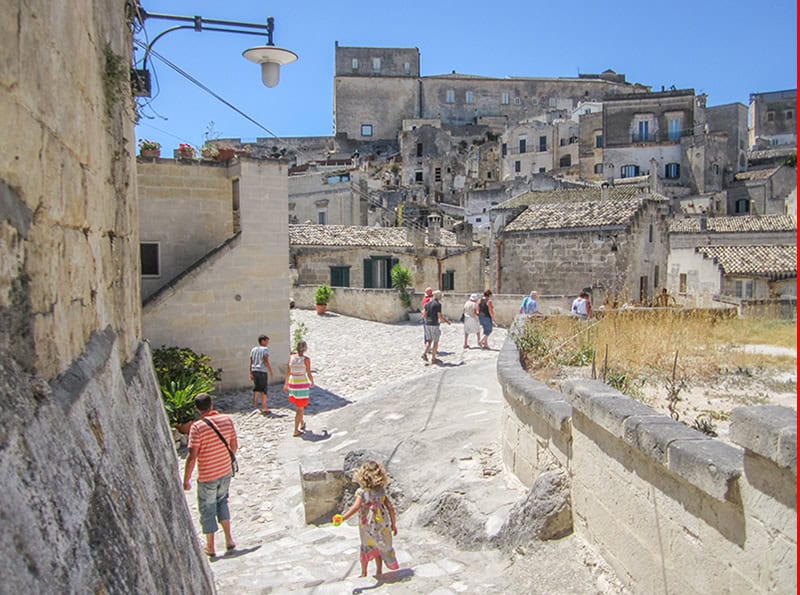
The Sassi – A Ready-Made Movie Set
Because of its historical significance, the Sassi, along with the rock-hewn churches of Matera, was designated a UNESCO World Heritage Site in 1993. A decade later, the bizarre cityscape began to attract filmmakers’ attention.
Films produced here include Mel Gibson’s “The Passion of the Christ” (2004), “Mary Magdalene” (2018), and “Wonder Woman” (2017). “No Time to Die” (2021) and “Ben-Hur” (2016) also utilized the Sassi for filming.
In fact, it became so popular that it began to be referred to as “Sassiwood.”
Looking out at the scores of television antennas poking up from the little cave homes in front of me, I thought it also would have been perfect as the location for some of the scenes in Star Wars.
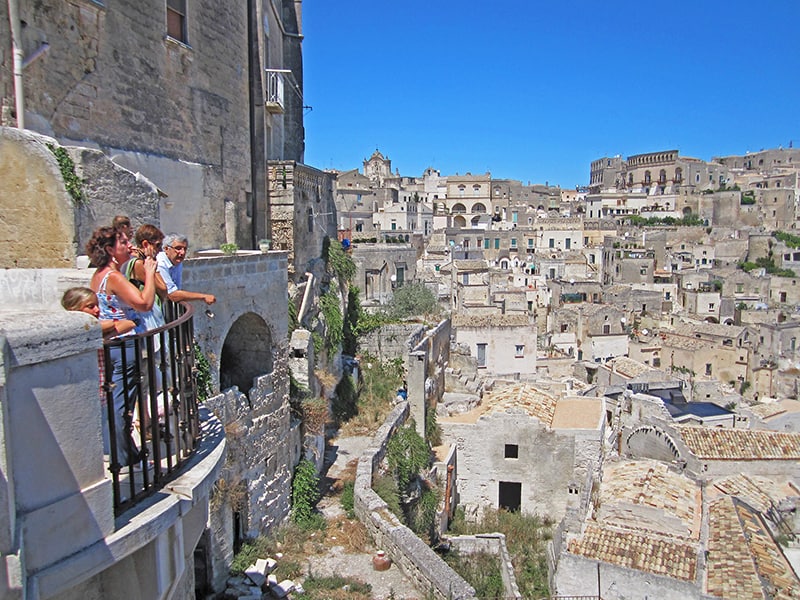
The Sassi Morphs Into a Tourist Attraction
The publicity from the movies and its UNESCO designation drew the interest of travelers and some local residents. Francis Ford Coppola’s opening of the Palazzo Margherita hotel in Bernalda, the 19th-century birthplace of his grandfather about 25 miles south, helped draw more attention.
Today, while many of the buildings remain crumbled and abandoned, local entrepreneurs have turned some into little bars and restaurants, apartments, cave hotels, and galleries. It all looks rather bizarre but in a charming way. Dark green shutters on some windows make the place more comforting.
We walked along the Strada Panoramica dei Sassi in the upper district, getting the city’s best views below. After a short time, we came to one of the entrance stairs down to the Sassi. We descended the steep stairs after passing a gaggle of touts offering their services as guides.
You may also enjoy: The Search for My Family in Italy / Top Places To Visit in Italy / Puglia Road Trip (With a Map) — Italy’s Sensational Adriatic Coast
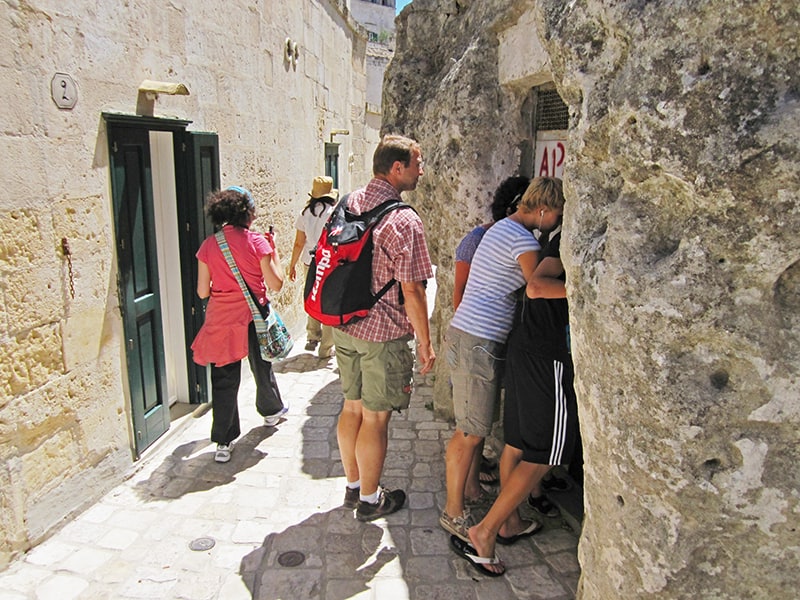
In Another World
We were soon in another world. Now, we saw a place with rocky dwellings strewn chaotically all over the landscape, sometimes one on top of another. It looked so much different from what it looked like above. We soon realized we could do nothing but wander Matera’s little streets aimlessly, which everyone else was doing.

We walked along a gorge and saw people climbing around the grassy hillside and in caves on the other side. On our side, the glare of the summer sun on the bright buildings and rocks seemed near-blinding at times.
Along the little streets, we soon passed signs for cave hotels, bars, and restaurants and found the places themselves: the Sassolino Bed-and-Breakfast, Ristorante Francesca, and the Kiev Café, where a group of Germans had stopped for lunch.
Many of our fellow explorers appeared to be Germans since eastern Italy—a fairly straight drive down to the heel of Italy’s boot from Munich—is a favorite vacation spot for them. In fact, when we were visiting, there were so many Germans that I thought I’d see schnitzel with pasta on some restaurant menus.
As we walked around the area, we also saw many little tourist stands, perhaps too many for an area so small. Everywhere, someone seemed to be selling postcards, ceramics, trinkets, and all sorts of little Sassi knickknacks.
As we passed yet another tchotchke stand, my wife expressed precisely what I had been thinking.
“I just hope they don’t ruin this place,” she said.

Leave a Reply